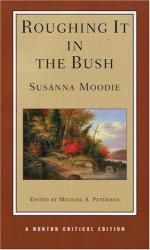Still confidently expecting to realise an income, however small, from the steam-boat stock, we had involved ourselves considerably in debt, in order to pay our servants and obtain the common necessaries of life; and we owed a large sum to two Englishmen in Dummer, for clearing ten more acres upon the farm. Our utter inability to meet these demands weighed very heavily upon my husband’s mind. All superfluities in the way of groceries were now given up, and we were compelled to rest satisfied upon the produce of the farm. Milk, bread, and potatoes during the summer became our chief, and often for months, our only fare. As to tea and sugar, they were luxuries we could not think of, although I missed the tea very much; we rang the changes upon peppermint and sage, taking the one herb at our breakfast, the other at our tea, until I found an excellent substitute for both in the root of the dandelion.
The first year we came to this country, I met with an account of dandelion coffee, published in the New York Albion, given by a Dr. Harrison, of Edinburgh, who earnestly recommended it as an article of general use.
“It possesses,” he says, “all the fine flavour and exhilarating properties of coffee, without any of its deleterious effects. The plant being of a soporific nature, the coffee made from it when drank at night produces a tendency to sleep, instead of exciting wakefulness, and may be safely used as a cheap and wholesome substitute for the Arabian berry, being equal in substance and flavour to the best Mocha coffee.”
I was much struck with this paragraph at the time, and for several years felt a great inclination to try the Doctor’s coffee; but something or other always came in the way, and it was put off till another opportunity. During the fall of ’35, I was assisting my husband in taking up a crop of potatoes in the field, and observing a vast number of fine dandelion roots among the potatoes, it brought the dandelion coffee back to my memory, and I determined to try some for our supper. Without saying anything to my husband, I threw aside some of the roots, and when we left work, collecting a sufficient quantity for the experiment, I carefully washed the roots quite clean, without depriving them of the fine brown skin which covers them, and which contains the aromatic flavour, which so nearly resembles coffee that it is difficult to distinguish it from it while roasting.
I cut my roots into small pieces, the size of a kidney-bean, and roasted them on an iron baking-pan in the stove-oven, until they were as brown and crisp as coffee. I then ground and transferred a small cupful of the powder to the coffee-pot, pouring upon it scalding water, and boiling it for a few minutes briskly over the fire. The result was beyond my expectations. The coffee proved excellent—far superior to the common coffee we procured at the stores.
To persons residing in the bush, and to whom tea and coffee are very expensive articles of luxury, the knowledge of this valuable property of a plant scattered so abundantly through their fields, would prove highly beneficial. For years we used no other article; and my Indian friends who frequented the house gladly adopted the root, and made me show them the whole process of manufacturing it into coffee.




